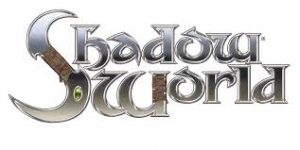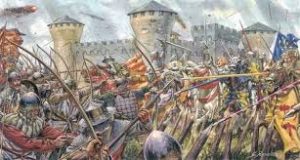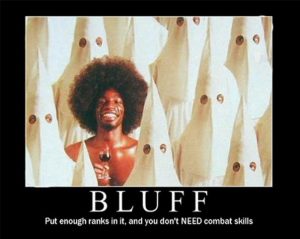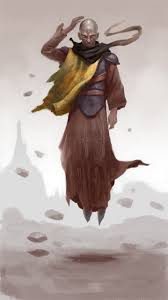
Anyone reading this RolemasterBlog should be familiar with Terry K. Amthor. One of the founding members of Iron Crown Enterprises and author of Court of Ardor, Lorien and Thieves of Tharbad (to name just a few). Terry is now the principal of Eidolon Studios where he continues to publish fantastic Shadow World material. There have been detailed accounts written about I.C.E. and their history and the epic battle for M.E. licensing, so I thought it would be enjoyable to get a more personal perspective from Terry himself.
BH: Terry, there have been several comprehensive articles about ICE and in depth interviews with I.C.E. founders but relatively few interviews with you. Anecdotally, there are few designers and authors that have survived on one setting or rule-set as long as you. Shadow World was introduced in 1989 and you’ve been the master architect for all of that time. Do you have thoughts or perceptions on your own role or influence on RPG’s?
TKA: Well, to be honest, I think what limited notoriety or influence I have had was my role in Middle-earth Role Playing, as the editor and author of several books. MERP was one of the biggest selling RPGs of all time after D&D. And I was happy to stand in Pete Fenlon‘s shadow; he’s kind of larger-than-life. But I’m also proud of my role in the creation of Rolemaster. Olivia Johnston and I basically invented the Mentalism realm, and many of those critical hits and spell lists were written by me. Now of course I look at RM and think that it is rather daunting. Ha! Regarding Shadow World, I was honored and excited that it was agreed that I would be the world creator. I built heavily on our work in Iron Wind and went from there.
And in a somewhat unrelated topic, I got a little fame for my article ‘Queer as a Three-sided Die’ in White Wolf Magazine back in 1994, about feeling isolated as the only gay gamer (besides one other guy in the industry) that I knew of. The WW guys said it got a tremendous response. The last few years at GenCon now they hold a seminar with that name.
BH: As you mentioned, your 1994 article in White Wolf “Queer as a Three-sided Die” helped motivate a recurring seminar at Gen-Con of the same name. You’ve included both gays and women in Shadow World: the Sarnak amazons and the Komaren Cluster “Sherikaan” (SW term for gays). There seems to be an emphasis on “minorities”, can you elaborate on that and its importance to you in your creative process
TKA: I dunno, it just seemed natural to me. I knew I was taking a risk of offending people including an entire gay culture in SW, but that was when I was writing SW unsupervised for the first time and thought, what the hell. (The main protagonist in my SW novel is also gay). I never got any negative feedback, and even got a few letters and emails praising it.
As far as women and other races, it just seemed natural to me, especially after Middle-earth, which is totally dominated by men, (except for Galadriel), and the only people of color were savages from Harad who served Sauron. Back in the 80’s the gaming world was overwhelmingly white and str8. Fortunately it has changed quite a bit, along with popular culture.
BH: Your background in architectural design must have played a role in your work. Is your creative process driven by physical design or does narrative drive the form factor?
‘but how does that work, really?’
TKA: Ha! Though in many ways I think my architecture experience helped, sometimes I think it has held me back from creating really exotic building designs. Pete would design these beautiful but totally impractical structures, and in the back of my mind I was always wondering. ‘but how does that work, really?’ I’ve gotten a little better at letting go over the years, I hope.
BH: One of your earlier SW products, Jaiman, had the Dragonlord fortress–that was pretty fantastical!
TKA: Heh, yes that was kind of wild. But to be honest, I can’t remember if my design came first, or if I had to retro-design it after the artist’s work. I think the latter.
BH: Many of us are in our 40’s or 50’s and consumers of early RPG’s in the heady days of the 80’s RPG industry. Early business successes are often attributed to “lightning in a bottle”–a mixture of right time, right place and right team. Charlottesville is a special place and UVA is an amazing institution. Certainly I.C.E. benefited from a confluence of factors: a start-up industry, Fenlon’s maps and the original ME campaign, your layouts and design aesthetic and a solid publishing team. I.C.E published A LOT of quality material in a short period of time, 1980-1990. What is your perspective of that time and the factors for success?
TKA: I have to say that I have often thought how different my life would be if I had not allowed myself to be talked into going to my first D&D session by a friend, way back in 1976 when I was first year in college. I loved LotR, but the game idea sounded silly to me. We went and I joined Pete’s early quest to destroy the Iron crown and I was hooked. Most of the people who would go on to found ICE were there. We had many all-nighter gaming sessions.
After ICE was established, we often joked that we were probably the only RPG company run by committee, for better or worse. All the other major companies of the time seemed to be run by one man. Pete was the driving force, but all of us founders had a voice. And yes we had an enormous pool of talent! Most of us were UVa grads, but we managed to get some great freelance artists and writers. It was an exciting time, especially the early 80’s. We all put in long hours, and often were down in shipping, collating and packing games.
“gold standard”
BH: MERP is considered a “gold standard” for M.E. reference material. Anecdotally I’ve heard that Peter Jackson used I.C.E. material in the LOTR production. Had you heard that?
TKA: Yes, that was amazing that Pete managed to secure the rights. And yes I heard that as well. And looking at the cover of ‘Lorien’ by Angus McBride (which I art directed), its hard not to think that he was inspired by some of our art and materials. I prefer to be flattered about that. However, how the license holders treated ICE when the movies were about to come out and they smelled big money, that was inexcusable.
BH: Many of the larger ME books are as much reference material as a gaming product. Were you all Tolkien scholars? With all the other product lines you were working on, how did the company manage the output and product quality? I can’t imagine many companies taking on the challenge of mapping Moria!
TKA: Pete and I both prided ourselves on being Tolkien ‘scholars’ and we researched what was available. I learned how to write Elven script, learned a lot of vocabulary, and got deep into the lineage of the Eldar, especially Galadriel and her history. It was an obsession of mine back then. Of course, sadly, most of that is gone from my brain-cells.
As far as quality, I don’t know, but we wanted to get it right when dealing with Middle-earth history, but make an exciting game. Meanwhile at ICE I moved from editor to production manager to art director, so it was a crazy time for a guy in his 20’s. I wouldn’t trade it for anything, even the office moves, the hiring, the buying new technology and being the go-to Mac geek (while we had Coleman the PhD in Computer Science, who was above that crap).
I was so excited to bring Kevin Barrett on with Space Master. (I actually drove up to Toronto with a monstrous KAYPRO computer to meet Kevin, and we spent a weekend working out Space Master. The whole thing started as a random mailed-in submission that Coleman and I both liked (that was rare!!!)
BH: How do you see Shadow World in the ecosystem of RPG settings?
TKA: I am pleased that it has survived and remains profitable, but these days it is kind of a niche setting, along with many others. Long gone are the huge print runs and massive distributor networks of the 80’s and 90’s. And from the beginning, SW suffered from some unfortunate compromises in the early days. I had to include Fantasy HERO stats, which took up a lot of space, and from what we could tell, there was very little interest from the FH players. I was also ‘encouraged’ to accept some less than high-quality modules that had little to do with my idea of SW. A couple of the other ICE principals strongly wanted SW to be very a generic, plug-and-play world, which I was strongly against.
I was grateful that, when I left ICE in 1992 and moved to Northern Virginia, Pete allowed me to take SW, and licensed RM to me for a minimal fee. That’s when I founded Eidolon Studio and began self-publishing. Then I could do whatever I wanted. SW did also maybe suffer because it got the reputation of being a high-powered world. I think that was possibly unfair; there were high-powered NPCs, but plenty of low-level adventure possibilities. It may have also suffered because it was tied so closely to Rolemaster, which had a rep as a complex high-powered system. SW is definitely a very narrow kind of setting. It is high fantasy with sci-fi elements (which people love or hate), and a very detailed history, with major plots going on that the PCs might never know about. Like Rolemaster, it might seem daunting to a GM just starting out, but I hear about people jumping in to SW all the time.
BH: MERP had the benefit of Tolkien’s world-building and history. Did that later influence your work on the extensive SW timeline? Not many settings have 110,000 year+ of back history!
TKA: Absolutely. I wanted SW to have a deep history of its own with legends and epic events that most current inhabitants assume are just stories. But the gods are real. And that ancient history is infused with tech, and even in the present, a space empire is watching Shadow World from orbit. It’s all kind of fun. One of my tenants of Shadow World Is the Arthur C. Clark Law “Any sufficiently advanced technology is indistinguishable from magic”
BH: Typeface/font choices have been an important design element for the Shadow World line. However, you made an abrupt change with the Xa’ar book. Any thoughts on that?
TKA: I had to go pull out a copy of Xa-ar to see what you meant. Back with Eidolon (before returning to the fold of the new ‘ICE’) I went a little crazy with typefaces. They can tell a story and add a lot of flavor. And the type foundry ‘P22’ came out with all these cool handwriting faces… I think I used a lot in a free downloadable file of handouts for the GM of clues.
BH: How do you think your SW writing has changed over time? The Emer box set and MA addendum had a much darker feel than the original SW box set. Eidolon had a touch of anime and steampunk. You’re now working on Wurilis; do you choose a tone first or does the tone reveal itself while you write?
TKA: To be honest, I had not noticed a change of tone. The books you refer to are 20 years back, and I was also production manager at ICE and fighting for some quiet time to write, so it’s hard to say. When I was close to a deadline on a SW book I would literally lock myself in my office, assign an assistant to run production (it was not that hard) and ask that no one disturb me for days. I don’t choose a ‘tone’ but Wuliris is an area with a lot of buried ancient tech, so that will be evident in the book. I always thought of SW as a dark place, what with Priests Arnak and evil gods, but I never wanted it to be gratuitous or gory (despite our critical hits, I guess!).
I do hope that my writing has improved through practice over the years. Practice, reading, practice!
BH: Let’s talk about your creative inspirations. You’ve mentioned your passion for Star Trek and it seems there is some anime influence as well? Any other movies, books or aesthetic that guides your work or has been an inspiration?
TKA: There’s no question that Anime has been an influence. I was totally in love with Hayao Miyazaki‘s ‘Laputa, City in the Sky.’ It was an influence for Eidolon, though of course the two are completely different cities. Miyazaki’s characters and storytelling, and his amazing steampunk settings, are really inspiring. His movies really inspired my vision of the SW steampunk Loari Elves. Watching his movies makes me feel young again.
BH: I occasionally see comments (or complaints) about the lack of new products for SW. But if you really look at the list of SW books there is easily enough material for YEARS of play. I think what people are saying is they want new material from you! That’s a good thing-right? Do you feel pressure from SW fans to “produce” or to come up with something new and original?
TKA: Well, we have built up a catalog, but obviously we are missing some key products like Emer I and II and Haalkitaine, so I am working on the revisions of those. I am a slow writer, but we also have some freelancer submissions that I am working on editing.
BH: You’ve recently moved back to Charlottesville after almost 25 years. Has that impacted your creative process–coming back to “where it all started”?
TKA: I love being back in this wonderful town; it is so unlike northern VA/DC. Part of me wishes I had never left, but water under the bridge. I am still getting fully settled and hope to meet up with more of my old friends again who are still here. I have a nice condo with a beautiful view out of my home office.
BH: Media companies often look for ways to monetize content they already own in different ways. For example, Disney is masterful about taking a brand and developing it through multiple channels: movies, books, games, toys etc. You’re doing that now with your Shadow World novel but have you thought about other opportunities? Certainly a d20 conversion of existing SW material could potentially open up a huge player market for you. Is there demand for licensing a SW creatures line to a miniatures company? That Eidolon map you had printed on canvas was fantastic (and a great gift item). I think someone did a SW comic book concept. Just throwing out ideas but wondering if you’ve explored anything.
TKA: A D20 version of the Atlas was started but several editors dropped the ball. It fell on my lap, but my knowledge of D20 was insufficient to do the system charts, so it once again fell by the wayside. As far as miniatures, that is outside of my arena. The current ICE owners could better answer.
BH: Given the size of the timeline, the number of Master Atlas editions there have been miscellaneous errata and inconsistencies in the SW books. Putting that aside, is there any earlier material you’d like to retcon to better fit your current view of Shadow World or something significant you’d change or delete?
TKA: Yes there are inconsistencies. SW needs a content editor. I’d really like someone to redo the Jaiman book as an atlas of the continent without all the dungeons.
BH: Imitation can be the sincerest form of flattery. Have you looked at any of the Numenera products? Multiple past ages, high tech, the “Iron Wind”, strange constructs and artificial creatures. While any RPG borrows from common tropes and memes, there seems to be a distinct bit of SW in Numenera. Any thoughts on that?
TKA: When Numenera came out, I admit I was a bit annoyed because it smelled like SW, and the game was selling on an idea of ancient tech, and that very evocative art of the floating crystal. And Monte worked at ICE during my Shadow World time. But Monte created a very different and compelling universe. If maybe SW inspired him, I’m flattered. I wish him the best.
BH: Some of the ICE founders have moved on to other gaming companies. Have you ever been interested, considered, or been approached to work at another gaming company. (besides your work with Kult)?
TKA: Pete and Coleman went on to Mayfair and of course, Catan! I could not be happier for them. But no, we don’t really talk about business.
BH: Given the various changes that have occurred at ICE, I think a lot of people are probably confused about the status of some of the older SW products. You mentioned Emer I, II and Haalkitaine. Can those just go through a reprint or do you need new material & artwork? Are there any other older products you would have liked to see re-published?
TKA: The Emers and Haalkitaine all suffer from sub-standard artwork (I was on a very tight budget, doing those books on my own!), and as the years went by, I thought of a lot more material I wanted to cover in those books (Emer III ended up being almost twice as large as those early books). So for me, new editions were imperative. Actually I am working on Haalkitaine and Emer I now; Haalkitaine might be out by the end of the year.
BH: The lack of a full-time employees and in-house resources must make it difficult to spin out new ideas or products. On the other hand, you have a fairly broad skill set: writer, designer, page layout, art etc and you continue to generate well produced and well-received products. Is there ever times when you feel like “ramping up” and growing Eidolon studios or even doing a Kickstarter campaign?
TKA: I’m not sure what you mean? Right now Eidolon pretty much exists to do ICE products. I am doing layout for some HARP books, which is some nice easy income, and hope to continue our relationship with producing mutually lucrative Shadow World books. I don’t really have the time (or much desire) to go off and do something independently outside of those borders. Some other publishers have had big success with kickstarters, but that’s really not my call.
BH: You seem to have covered all the major elements in the “SW story”: gods, major organizations, key artifacts, etc. With this framework in place, is it now just “filling in the gaps” with regional material like Wurilis and Emer IV?
TKA: Pretty much! I mean, should I ever get bored with this hemisphere, there is always the East, beyond the Barrier. But there is still so much to tell here.
BH: Between the Grand Campaign, the timeline and your Shadow World novel, the larger meta-narrative appears to be heading towards a climactic conclusion. Do you have the major plot points outlined? Are there any new elements that have yet to be introduced to GM’s or players in the books so far? (spoiler-free of course)
TKA: Heh-heh. Yes, events seem to be heading to a few major confrontations. The novel obviously uses the characters I’ve created, but I assume that GMs will put their own PCs in those key positions where they can ‘save the world’ if they desire. And at the rate I am going, the big catastrophe is years away in real-world terms…
BH: Are there any other continents besides Emer and Jaiman that you’ve written notes/materials that you’d like to tackle?
TKA: A couple (Folenn and Falias) are kind of taken-care of. I would like to go southwest to Thuul…
BH: Throughout the SW books there are tantalizing tidbits or references to things, places or people that haven’t been covered yet. (My favorite is the Mazatlak Pillar City). Is there any person/place/thing that you’ve referenced that you’d like to explore further?
TKA: I’d like to learn about Mazatlak Pillar City too! 😉 Yes, in the Atlas (and in the Emer I maps) I designated a bunch of locations with little or no description. They were mainly meant as teasers for the GM to develop, but I may get to some of them eventually.
BH: You commented that you weren’t happy with the art in Emer I and Haalkitaine but I’d like to get your thoughts on RPG artwork for the last few decades. Like D&D, ICE started with b&w line illustrations and hand drawn layouts and regional maps. You then oversaw the artwork for MERP and the popular Angus McBride covers (which might have influenced the artwork for the LOTR movies). I recall you diving into computer rendered art for the Shadow World website in the 90’s. Now RPG’s have embraced full color illustrations that seem drawn out of computer gaming: exaggerated or out of scale features or excess musculature drawn from comic book aesthetics. There has been some comments on the forums about re-introducing hand drawn and colored maps but that sounds a bit too labor intensive? That’s a lot to unpack, but I guess the question is. if and how has your artistic sensibility has changed over the years?
TKA: That is a long, complicated, and unfortunately often painful story. Back in the old ICE, we often were very late in paying artists (and sadly, I fear ICE did not pay some artists what they were owed, but I am not sure. I had no control over how money was paid out). This continued until the current managers (GuildCompanion), who are very careful about staying in budget and paying on time. However, with smaller numbers of product sold ICE cannot afford the prices of the well-known hand-drawing artists any more.
(re: the Emer and Haalkitaine art, I got that mostly from copyright-free books and um, other sources.)
I experimented with computer rendering back in the 90’s with a little program called Bryce, which was great for landscapes, but sucked beyond that (and print-quality renderings took hours, even on the most powerful Macs back then). But again, I had no money, and it seemed like a way to convey some atmosphere. I know some people resist it even now, despite the gorgeous renderings by our artist Craig, but I think they really convey the Shadow World.
Now, since we are doing Shadow World books in full color, we are sticking with computer renders for illustrations (I work very closely with Craig to get the scenes, characters and costumes just right), and we will mix hand-drawn and computer maps.
BH: Last question. Most SW products are a combination of small narrative vignettes, text body and stats. When you are writing a product do you develop the three in a linear fashion? Write the copy first and then the stats? Floorplans first? Do you have a writing process or system that you’ve developed over the years?
Using my current work on Emer IV and NE Jaiman as a guide, I guess I start with the big picture, and almost naturally work through a book in a similar way to which it is presented. I do the geography and environment, governments, then towns and interactions, then bore down to individuals, interesting characters. Adventures and floorplans are usually last. I find it hard to write adventures.
As a side note, the novel came out a result of a series of ‘Kalen’s journal entries’ I published on an old web site years ago, which people seemed to enjoy and thought gave the SW some additional personal life.
BH: Thanks Terry. We all waited for each new addition to the “Journals of Kalen Avanir” back in the day! It’s interesting to note that “serial stories” like yours are all the rage now on the internet. You were a pioneer!
Anyway, I want to thank you for decades of inspiration, great gaming sessions and creative content! For those that want a more detailed background for Terry you can see his wiki HERE. If you are interested in Shadow World you should check out Eidolon Studios and the Shadow World Forum.










